Black And Decker PS9600 Handleiding
Black And Decker
Boormachine
PS9600
Bekijk gratis de handleiding van Black And Decker PS9600 (6 pagina’s), behorend tot de categorie Boormachine. Deze gids werd als nuttig beoordeeld door 46 mensen en kreeg gemiddeld 4.4 sterren uit 23.5 reviews. Heb je een vraag over Black And Decker PS9600 of wil je andere gebruikers van dit product iets vragen? Stel een vraag
Pagina 1/6

GENERAL SAFETY RULES - FOR ALL BATTERY OPERATED TOOLS
WARNING! READ AND UNDERSTAND ALL INSTRUCTIONS. Failure to follow all
instructions listed below, may result in electric shock, fire and/or serious personal injury
SAVE THESE INSTRUCTIONS
WORK AREA
•Keep your work area clean and well lit. Cluttered benches and dark areas invite accidents.
• Do not operate power tools in explosive atmospheres, such as in the presence of
flammable liquids, gases, or dust. Power tools create sparks which may ignite the dust or
fumes.
• Keep bystanders, children, and visitors away while operating a power tool.
Distractions can cause you to lose control.
ELECTRICAL SAFETY
• Do not abuse the cord. Never use the cord to carry the tool. Keep cord away from
heat, oil, sharp edges or moving parts. Replace damaged cords immediately.
Damaged cords may create a fire.
• A battery operated tool with integral batteries or a separate battery pack must be
recharged only with the specified charger for the battery. A charger that may be suitable
for one type of battery may create a risk of fire when used with another battery.
• Use battery operated tool only with specifically designated battery pack. Use of any
other batteries may create a risk of fire.
PERSONAL SAFETY
• Stay alert, watch what you are doing and use common sense when operating a power
tool. Do not use tool while tired or under the influence of drugs, alcohol, or
medication. A moment of inattention while operating power tools may result in serious
personal injury,
• Dress properly. Do not wear loose clothing or jewelry. Contain long hair. Keep your
hair, clothing , and gloves away from moving parts. Loose clothes, jewelry, or long hair
can be caught in moving parts. Air vents cover moving parts and should be avoided.
• Avoid accidental starting. Be sure switch is in the locked or off position before
inserting battery pack. Carrying tools with your finger on the switch or inserting the battery
pack into a tool with the switch on invites accidents.
• Remove adjusting keys or wrenches before turning the tool on. A wrench or a key that is
left attached to a rotating part of the tool may result in personal injury.
• Do not overreach. Keep proper footing and balance at all times. Proper footing and
balance enable better control of the tool in unexpected situations.
• Use safety equipment. Always wear eye protection. Dust mask, non-skid safety shoes,
hard hat, or hearing protection must be used for appropriate conditions.
TOOL USE AND CARE
• Use clamps or other practical way to secure and support the workpiece to a stable
platform. Holding the work by hand or against your body is unstable and may lead to loss of
control.
• Do not force tool. Use the correct tool for your application. The correct tool will do the
job better and safer at the rate for which it is designed.
• Do not use tool if switch does not turn it on or off. A tool that cannot be controlled with the
switch is dangerous and must be repaired.
• Disconnect battery pack from tool or place the switch in the locked or off position
before making any adjustments, changing accessories, or storing the tool. Such
preventative safety measures reduce the risk of starting the tool accidentally.
• Store idle tools out of reach of children and other untrained persons. Tools are
dangerous in the hands of untrained users.
• When battery pack is not in use, keep it away from other metal objects like: paper
clips, coins, keys, nails, screws or other small metal objects that can make a
connection from one terminal to another. Shorting the battery terminals together may
cause sparks, burns, or a fire.
• Maintain tools with care. Keep cutting tools sharp and clean. Properly maintained tools,
with sharp cutting edge are less likely to bind and are easier to control.
• Check for misalignment or binding of moving parts, breakage of parts, and any other
condition that may affect the tool’s operation. If damaged, have the tool serviced
before using. Many accidents are caused by poorly maintained tools.
• Use only accessories that are recommended by the manufacturer for your model.
Accessories that may be suitable for one tool may create a risk of injury when used on
another tool.
SERVICE
• Tool service must be performed only by qualified repair personnel. Service or
maintenance performed by unqualified personnel may result in a risk of injury.
• When servicing a tool, use only identical replacement parts. Follow instructions in the
Maintenance section of this manual. Use of unauthorized parts or failure to follow
Maintenance Instructions may create a risk of shock or injury.
SPECIFIC SAFETY RULES
• Hold tool by insulated gripping surfaces when performing an operation where the
cutting tool may contact hidden wiring or its own cord. Contact with a "live" wire will also
make exposed metal parts of the tool "live" and shock the operator.
• When working on a ladder or on scaffolding be sure to lay the tool down on its side
when not in use. Some tools with large battery packs will stand upright but may be easily
knocked over.
The label on your tool may include the following symbols.
V ..........................volts A..........................amperes
Hz ........................hertz W ........................watts
min ........................minutes ......................alternating current
......................direct current no ........................no load speed
..........................Class II Construction ........................earthing terminal
........................safety alert symbol .../min ..................revolutions or
reciprocations
per minute
WARNING: Some dust created by power sanding, sawing, grinding, drilling, and other
construction activities contains chemicals known to cause cancer, birth defects or other
reproductive harm. Some examples of these chemicals are:
• lead from lead-based paints,
• crystalline silica from bricks and cement and other masonry products, and
• arsenic and chromium from chemically-treated lumber. (CCA)
Your risk from these exposures varies, depending on how often you do this type of work. To
reduce your exposure to these chemicals: work in a well ventilated area, and work with
approved safety equipment, such as those dust masks that are specially designed to filter
out microscopic particles.
•Avoid prolonged contact with dust from power sanding, sawing, grinding, drilling, and
other construction activities. Wear protective clothing and wash exposed areas with
soap and water. Allowing dust to get into your mouth, eyes, or lay on the skin may promote
absorption of harmful chemicals.
WARNING: Use of this tool can generate and/or disburse dust, which may cause serious
and permanent respiratory or other injury. Always use NIOSH/OSHA approved respiratory
protection appropriate for the dust exposure. Direct particles away from face and body.
BATTERY CAP INFORMATION
Battery storage and carrying caps are provided for use whenever the battery is out of the tool
or charger. Remove cap before placing battery in charger or tool.
WARNING! Do not store or carry battery so that metal objects can contact exposed
battery terminals. For example, do not place battery in aprons, pockets, tool boxes, product
kit boxes, drawers, etc. with loose nails, screws, keys, etc. without battery cap. Without cap
in place, battery could short circuit causing fire or burns or damage to battery.
Safety Warnings and Instructions: Charging the Drill
1. This manual contains important safety and operating instructions.
2. Before using battery charger, read all instructions and cautionary markings on (1) battery
charger, (2) battery, and (3) product using battery.
3. CAUTION: To reduce the risk of injury, charge only Black & Decker Power Packs.
Other types of batteries may burst causing personal injury and damage.
4. Do not expose charger to rain or snow.
5. Use of an attachment not recommended or sold by Black & Decker may result in a risk of
fire, electric shock, or injury to persons.
VEA EL ESPAÑOL EN LA CONTRAPORTADA.
SAVE THIS MANUAL FOR FUTURE REFERENCE.
INSTRUCTIVO DE OPERACIÓN, CENTROS DE SERVICIO Y
PÓLIZA DE GARANTÍA. LÉASE ESTEADVERTENCIA:
INSTRUCTIVO ANTES DE USAR EL PRODUCTO.
7
7
7
7
7
7
7
7
7
7.
.
.
.
.
.
.
.
.
.2
2
2
2
2
2
2
2
2
2,
,
,
,
,
,
,
,
,
,
9
9
9
9
9
9
9
9
9
9.
.
.
.
.
.
.
.
.
.6
6
6
6
6
6
6
6
6
6V
V
V
V
V
V
V
V
V
V,
,
,
,
,
,
,
,
,
,
1
1
1
1
1
1
1
1
1
12
2
2
2
2
2
2
2
2
2V
V
V
V
V
V
V
V
V
V,
,
,
,
,
,
,
,
,
,
1
1
1
1
1
1
1
1
1
14
4
4
4
4
4
4
4
4
4.
.
.
.
.
.
.
.
.
.4
4
4
4
4
4
4
4
4
4V
V
V
V
V
V
V
V
V
V,
,
,
,
,
,
,
,
,
,
&
&
&
&
&
&
&
&
&
&
1
1
1
1
1
1
1
1
1
18
8
8
8
8
8
8
8
8
8V
V
V
V
V
V
V
V
V
V
3
3
3
3
3
3
3
3
3
3/
/
/
/
/
/
/
/
/
/8
8
8
8
8
8
8
8
8
8"
"
"
"
"
"
"
"
"
"
C
C
C
C
C
C
C
C
C
CO
O
O
O
O
O
O
O
O
OR
R
R
R
R
R
R
R
R
RD
D
D
D
D
D
D
D
D
DL
L
L
L
L
L
L
L
L
LE
E
E
E
E
E
E
E
E
ES
S
S
S
S
S
S
S
S
SS
S
S
S
S
S
S
S
S
S
D
D
D
D
D
D
D
D
D
DR
R
R
R
R
R
R
R
R
RI
I
I
I
I
I
I
I
I
IL
L
L
L
L
L
L
L
L
LL
L
L
L
L
L
L
L
L
LS
S
S
S
S
S
S
S
S
S
Cat. Nos. PS7200, PS9600, PS1200, PS1440, PS1800 Form No. 5102751-00
(FEB-03-2) Copyright©2003 Black & Decker Printed in China
INSTRUCTION MANUAL
Catalog Nos. PS7200, PS9600,
PS1200, PS1440, PS1800
BEFORE RETURNING THIS PRODUCT
FOR ANY REASON PLEASE CALL
1-800-544-6986
IF YOU SHOULD HAVE A QUESTION OR EXPERIENCE A
PROBLEM WITH YOUR BLACK & DECKER PRODUCT,
CALL 1-800-544-6986
BEFORE YOU CALL, HAVE THE FOLLOWING INFORMATION AVAILABLE, CATALOG No., TYPE No., AND
DATE CODE (e.g. 20000130M). IN MOST CASES, A REPRESENTATIVE CANBLACK & DECKER
RESOLVE YOUR PROBLEM OVER THE PHONE. IF YOU HAVE ASUGGESTION OR COMMENT, GIVE
US ACALL. YOUR FEEDBACK IS VITALTO BLACK & DECKER.
K
K
K
K
K
K
K
K
K
KE
E
E
E
E
E
E
E
E
EY
Y
Y
Y
Y
Y
Y
Y
Y
YI
I
I
I
I
I
I
I
I
IN
N
N
N
N
N
N
N
N
NF
F
F
F
F
F
F
F
F
FO
O
O
O
O
O
O
O
O
OR
R
R
R
R
R
R
R
R
RM
M
M
M
M
M
M
M
M
MA
A
A
A
A
A
A
A
A
AT
T
T
T
T
T
T
T
T
TI
I
I
I
I
I
I
I
I
IO
O
O
O
O
O
O
O
O
ON
N
N
N
N
N
N
N
N
NY
Y
Y
Y
Y
Y
Y
Y
Y
YO
O
O
O
O
O
O
O
O
OU
U
U
U
U
U
U
U
U
US
S
S
S
S
S
S
S
S
SH
H
H
H
H
H
H
H
H
HO
O
O
O
O
O
O
O
O
OU
U
U
U
U
U
U
U
U
UL
L
L
L
L
L
L
L
L
LD
D
D
D
D
D
D
D
D
DK
K
K
K
K
K
K
K
K
KN
N
N
N
N
N
N
N
N
NO
O
O
O
O
O
O
O
O
OW
W
W
W
W
W
W
W
W
W:
:
:
:
:
:
:
:
:
:
• Charge battery for 9 hours before first use. For more information see
“CHARGING THE POWER PACK”.
7
12
43
56

6. To reduce risk of damage to electric plug and cord, pull by plug rather than cord when
disconnecting charger.
7. Make sure cord is located so that it will not be stepped on, tripped over, or otherwise sub-
jected to damage or stress.
8. An extension cord should not be used unless absolutely necessary. Use of improper
extension cord could result in a risk of fire, electric shock or electrocution.
a. Two-wire cords can be used with 2-wire or 3-wire extension cords. Only round jacketed
extension cords should be used, and we recommend that they be listed by Underwriters
Laboratories (U.L.). If the extension is to be used outside, the cord must be suitable for
outdoor use. Any cord marked for outdoor use can also be used for indoor work. The let-
ters "W" or "WA" on the cord jacket indicate that the cord is suitable for outdoor use.
b. An extension cord must have adequate wire size (AWG or American Wire Gauge) for
safety, and to prevent loss of power and overheating. The smaller the gauge number of
the wire, the greater the capacity of the cable; that is, 16 gauge has more capacity than
18 gauge. When using more than one extension to make up the total length, be sure
each extension contains at least the minimum wire size.
CHART FOR MINIMUM WIRE SIZE (AWG)OF EXTENSION CORDS
NAMEPLATE RATING AMPS – 0 – 10.0
Total Extension Cord Length (ft) 25 50 75 100 125 150
Wire Gauge 18 18 16 16 14 14
9. Use only the supplied charger when charging your drill. The use of any other charger
could damage the drill or create a hazardous condition.
10. Use only one charger when charging.
11. Do not attempt to open the charger or the drill. There are no customer serviceable parts
inside. Return to any authorized Black & Decker service center.
12. DO NOT incinerate the drill or battery packs even if they are severely damaged or com-
pletely worn out. The batteries can explode in a fire.
13. Do not incinerate the batteries. They can explode in a fire. A small leakage of liquid from
the battery cells may occur under extreme usage, charging or temperature conditions.
This does not indicate a failure. However, if the outer seal is broken and this leakage gets
on your skin:
a. Wash quickly with soap and water.
b. Neutralize with a mild acid such as lemon juice or vinegar.
c. If the battery liquid gets in your eyes, flush them with clean water for a minimum of 10
minutes and seek immediate medical attention. MEDICAL NOTE: The liquid is a 25-35%
solution of potassium hydroxide.
CHARGING THE POWER PACK
THE BATTERIES IN YOUR POWER PACK ARE NOT FULLY CHARGED AT THE
FACTORY. BEFORE ATTEMPTING TO CHARGE THEM, THOROUGHLY READ ALL OF
THE SAFETY INSTRUCTIONS.
The charger is designed to use standard household 120 volt 60 Hz power.
1. Make sure the battery is fitted into the drill as shown in Figure 1. Insert the charger plug
into the connector as shown in Figure 2.
2. Plug the charger into any standard 120 Volt 60 Hz electrical outlet and let the battery
charge initially for . After the initial charge, under normal usage, your power pack9 hours
should be fully charged in 3 to 6 hours.
3. Disconnect the tool from the charger. WARNING: Do not use the tool while it is con-
nected to the charger.
IMPORTANT CHARGING NOTES
1. After normal usage, your power pack should be fully charged in 3 to 6 hours. If the power
pack is run-down completely, it may take up to 6 hours to become fully charged. Your
power pack was sent from the factory in an uncharged condition. Before attempting to
use it, it must be charged for at least 9 hours.
2. DO NOT charge the power pack in an air temperature below 40°F or above 105°F. This
is important and will prevent serious damage to the power pack. Longest life and best
performance can be obtained if power pack is charged when air temperature is about
75°F.
3. While charging, the charger may hum and become warm to touch. This is a normal con-
dition and does not indicate a problem.
4. If the power pack does not charge properly—(1) Check current at receptacle by plugging
in a lamp or other appliance. (2) Check to see if receptacle is connected to a light switch
which turns power off when you turn out the lights. (3) Move charger and power pack to
a surrounding air temperature of 40°F to 105°F. (4) If the receptacle and temperature are
OK, and you do not get proper charging, take or send the power pack and charger to your
local Black & Decker service center. See Tools Electric in yellow pages.
5. The power pack should be recharged when it fails to produce sufficient power on jobs
which were easily done previously. DO NOT CONTINUE using product with its power
pack in a depleted condition.
6. To prolong power pack life, avoid leaving the power pack on charge for extended periods
of time (over 30 days without use). Although overcharging is not a safety concern, it can
significantly reduce overall power pack life.
7. The power pack will reach optimum performance after being cycled 5 times during normal
usage. There is no need to run the batteries down completely before recharging. Normal
usage is the best method of discharging and recharging the batteries.
Safety Warnings and Instructions: Drills
1. Hold drill firmly to control the twisting action of the drill. See Figure 3.
2. When attaching accessories in the drill chuck, hand tighten the keyless chuck firmly.
WARNING: Drill may stall (if overloaded or improperly used) causing a twist. Always
expect the stall. Grip the drill firmly to control the twisting action (see Fig. 3) and prevent loss
of control which could cause personal injury. If a stall does occur, release the trigger
immediately and determine the reason for the stall before re-starting.
Operating Instructions
FITTING AND REMOVING A DRILL BIT OR SCREWDRIVER BIT (FIGURE 4)
WARNING: First remove the battery from the tool.
This tool is equipped with a keyless chuck to allow for easy exchange of bits.
• Lock the tool by setting the forward/reverse slider (2) to the center position.
• Open the chuck by turning the front part (11) with one hand while holding the rear part (12)
with the other (Figure 4).
• Insert the bit shank (13) into the chuck.
• Firmly tighten the chuck by turning the front part (11) with one hand while holding the rear
part (12) with the other.
SELECTING THE DIRECTION OF ROTATION (FIGURE 5)
A forward/reverse control slider (2) determines the direction of the tool and also serves as a
lock off. To select forward rotation, push the forward/reverse slider to the left. To select
reverse rotation, depress the forward/reverse slider to the right. To lock the tool, set the
forward/reverse slider into the center position.
SELECTING THE OPERATING MODE OR TORQUE (FIGURE 6)
This tool is fitted with a collar to select the operating mode and to set the torque for tightening
screws. Large screws and hard workpiece materials require a higher torque setting than
small screws and soft workpiece materials.
• For drilling in wood, metal and plastics, set the collar (3) to the drilling position by aligning
the symbol with the marking (15).
• For screwdriving, set the collar to the desired setting. If you do not yet know the appropri-
ate setting, proceed as follows:
• Set the collar (3) to the lowest torque setting.
• Tighten the first screw.
• If the clutch ratchets before the desired result is achieved, increase the collar setting and
continue tightening the screw. Repeat until you reach the correct setting. Use this setting
for the remaining screws.
Drilling
• Use sharp drill bits only.
• Support and secure work properly, as instructed in the Safety Instructions.
• Use appropriate and required safety equipment, as instructed in the safety instructions.
• Secure and maintain work area, as instructed in the safety instructions.
• Run the drill very slowly, using light pressure, until the hole is started enough to keep the
drill bit from slipping out of it.
• Apply pressure in a straight line with the bit. Use enough pressure to keep the bit biting
but not so much as to stall the motor or deflect the bit.
R N ÈGLES GÉ ÉRALES DE SÉCURITÉ – POUR TOUS LES OUTILS À
PILES
AVERTISSEMENT! S'ASSURER DE LIRE ET DE BIEN COMPRENDRE TOUTES LES
CONSIGNES. Le non-respect des consignes indiquées ci-après peut causer un choc
électrique, un incendie ou des blessures graves.
CONSERVEZ CES DIRECTIVES
ZONE DE TRAVAIL
• Garder la zone de travail propre et bien éclairée. Les établis encombrés et les endroits
sombres sont propices aux accidents.
• Ne pas utiliser les outils électriques dans une atmosphère explosive, comme à
proximité de liquides, de gaz ou de poussières inflammables. Les outils électriques
créent des étincelles qui peuvent enflammer les poussières ou les vapeurs environnantes.
• Tenir les visiteurs, les enfants, ou toute autre personne à l’écart lorsqu’on utilise un
outil électrique. Les distractions peuvent faire perdre la maîtrise de ce dernier.
MESURES DE S : ÉCURITÉ ÉLECTRICITÉ
• Ne pas utiliser le cordon de manière abusive. On ne doit pas transporter l’outil en le
tenant par le cordon. On doit tenir le cordon à l’écart des sources de chaleur, de
l’huile, des bords tranchants ou des pièces mobiles. Remplacer immédiatement les
cordons endommagés, car ces derniers augmentent les risques d’incendie.
• IUn outil à piles intégrées ou à bloc-piles externe doit être rechargé seulement au
moyen du chargeur approprié, car un chargeur destiné à une pile particulière pourrait
entraîner un risque d’incendie lorsqu’il est utilisé avec une autre.
• N’utiliser l’outil à piles qu’avec le bloc-piles désigné, car l’utilisation d’un autre type de
piles pourrait entraîner un risque d’incendie.
AVANT DE RETOURNER CE PRODUIT POUR QUELQUE RAI-
SON QUE CE SOIT, COMPOSEZ LE
1 800 544-6986
Perceuses sans fil de 3/8 po
• Hold the drill firmly to control its twisting action.
• DO NOT CLICK THE TRIGGER OF A STALLED DRILL OFF AND ON IN AN ATTEMPT
TO START IT. DAMAGE TO THE DRILL CAN RESULT.
• Minimize stalling on breakthrough by reducing pressure and slowly drilling through last
part of hole.
• Keep the motor running while pulling the bit out of a drilled hole This will help reduce jam-
ming.
• Use a cutting lubricant when drilling metals. The exceptions are cast iron and brass which
should be drilled dry. Lubricants that work best are sulphurized cutting oil or lard oil.
• When using twist drill bits to drill holes in wood, it will be necessary to pull the bits out fre-
quently to clear chips from the flutes.
•Make sure switch turns drill on and off.
WARNING: It is important to support work properly and to hold the drill firmly to prevent
loss of control which could cause personal injury If you have questions on how to operate
tool, call: 1-800-544-6986.
Maintenance
Use only mild soap and damp cloth to clean the tool. Never let any liquid get inside the tool;
never immerse any part of the tool into a liquid. IMPORTANT: To assure product SAFETY
and RELIABILITY, repairs, maintenance and adjustment should be performed by authorized
service centers or other qualified service organizations, always using identical replacement
parts.
The RBRC Seal™
The RBRC™ (Rechargeable Battery Recycling Corporation)Seal on the nickel-
cadmium battery (or battery pack) indicates that the costs to recycle the battery (or
battery pack) at the end of its useful life have already been paid by Black & Decker.
In some areas, it is illegal to place spent nickel-cadmium batteries in the trash or
municipal solid waste stream and the RBRC program provides an environmentally conscious
alternative.
RBRC in cooperation with Black & Decker and other battery users, has established
programs in the United States and Canada to facilitate the collection of spent nickel-
cadmium batteries. Help protect our environment and conserve natural resources by
returning the spent nickel-cadmium battery to an authorized Black & Decker service center
or to your local retailer for recycling. You may also contact your local recycling center for
information on where to drop off the spent battery, or call 1-800-8-BATTERY.
Accessories
Recommended accessories for use with your tool are available from your local dealer or
authorized service center. If you need assistance regarding accessories, please call: 1-800-
544-6986. The following accessories should be used only in the sizes specified below: BITS,
METAL DRILLING – Up to 3/8" (9.5mm); BITS, MASONRY DRILLING – Up to 3/8" (9.5mm);
WOOD DRILLING – Up to 1/2" (12.7mm).
WARNING: The use of any accessory not recommended for use with this tool could be
hazardous.
Full Two-Year Home Use Warranty
Black & Decker (U.S.) Inc. warrants this product for two years against any defects in material
or workmanship. The defective product will be replaced or repaired at no charge in either of
two ways. The first, which will result in exchanges only, is to return the product to the retailer
from whom it was purchased (provided that the store is a participating retailer). Returns
should be made within the time period of the retailer’s policy for exchanges (usually 30 to 90
days after the sale). Proof of purchase may be required. Please check with the retailer for
their specific return policy regarding returns that are beyond the time set for exchanges.
The second option is to take or send the product (prepaid) to a Black & Decker owned or
authorized Service Center for repair or replacement at our option. Proof of purchase may be
required. Black & Decker owned and authorized service centers are listed under "Tools-
Electric" in the yellow pages of the phone directory.
This warranty does not apply to accessories. This warranty gives you specific legal rights and
you may have other rights which vary from state to state. Should you have any questions,
contact the manager of your nearest Black & Decker Service Center. This product is not
intended for commercial use.
See ‘Tools-Electric’
– Yellow Pages –
for Service & Sales
Imported by
Black & Decker (U.S.) Inc.,
701 E. Joppa Rd.
Towson, MD 21286 U.S.A.
IMPORTANTS RENSEIGNEMENTS :
•Charger la pile pendant 9 heures avant de l’ èutiliser pour la premi re fois. Pour de
plus amples renseignements, voir la section intitul CHARGEMENT DU BLOC-ée «
PILE ».
GUIDE D'UTILISATION
Numéros de catalogue PS7200, PS9600, PS1200, PS1440, PS1800
SI VOUS ÉPROUVEZ UN PROBLÈME AVEC CE PRODUIT DE BLACK & DECKER,
COMPOSEZ LE 1-800-544-6986
AVANT D’APPELER, VEUILLEZ VOUS ASSURER D’AVOIR L’INFORMATION SUIVANTE À
PORTÉE DE LA MAIN : LE NUMÉRO DE CATALOGUE, LE NUMÉRO DE PRODUIT ET LE
CODE DE DATATION (P. EX., 20000130M). DANS LA MAJORITÉ DES CAS, LE
REPRÉSENTANT BLACK & DECKER SERA EN MESURE DE LE RÉSOUDRE PAR
TÉLÉPHONE. VEUILLEZ NOUS FAIRE PART DE VOS QUESTIONS OU DE VOS COM-
MENTAIRES EN COMPOSANT LE MÊME NUMÉRO, CAR CEUX-CI AIDENT À ASSURER
LA RÉUSSITE DE NOTRE PROGRAMME D'AMÉLIORATION DE LA QUALITÉ.

SÉCURITÉ PERSONNELLE
• Rester vigilant en tout temps et faire preuve de jugement lorsqu’on utilise un outil
électrique; ne pas utiliser l’outil lorsqu’on est fatigué ou sous l’influence de drogues,
d’alcool ou de médicaments, car un moment d’inattention pourrait entraîner des blessures
graves.
•Porter des vêtements appropriés; ne pas porter de vêtements amples ni de bijoux.
Couvrir ou attacher les cheveux longs. Garder les cheveux, les vêtements, les bijoux
et les gants éloignés des pièces mobiles, car ceux-ci peuvent s’y coincer. Se tenir
éloigné des évents puisque ces derniers pourraient camoufler des pièces mobiles.
•Éviter les démarrages accidentels; s’assurer que l’interrupteur soit placé en position
de verrouillage ou d’arrêt avant d’insérer le bloc-piles. Ne pas transporter l’outil en
laissant le doigt sur l’interrupteur ni insérer le bloc-piles lorsque l’outil est en position de
marche, car cela pourrait causer un accident.
•Retirer les clés de réglage avant de démarrer l’outil; une clé laissée sur une pièce
rotative pourrait entraîner des blessures.
•Ne pas trop étendre les bras; les pieds doivent rester ancrés fermement sur le sol afin
de maintenir son équilibre en tout temps temps et de mieux maîtriser l’outil dans des
situations imprévues.
•Utiliser le matériel de sécurité approprié; toujours porter des lunettes de protection.
Porter un masque anti-poussières, des chaussures antidérapantes, un casque de sécurité
ou des protecteurs auditifs lorsque la situation le requiert.
UTILISATION ET ENTRETIEN DE L’OUTIL
•Fixer et soutenir l’ouvrage sur une plate-forme stable au moyen d’une butée fixe ou de
tout autre dispositif semblable; l’ouvrage est instable lorsqu’on le retient manuellement
ou qu’on l’appuie contre le corps, ce qui pourrait faire perdre la maîtrise de l’outil.
•Ne pas forcer l’outil ni l’utiliser pour des travaux autres que ceux pour lesquels il a été
conçu. Pour obtenir de meilleurs résultats et prévenir les risques de blessure, laisser l’outil
couper à la vitesse pour laquelle il a été conçu.
•Ne pas utiliser l’outil lorsque l’interrupteur de marche-arrêt ne fonctionne pas; tout
outil qui ne peut être commandé au moyen de l’interrupteur est dangereux et doit être
réparé.
•Débrancher le bloc-piles de l’outil ou mettre l’interrupteur en position de verrouillage
ou d’arrêt avant d’effectuer un réglage, de changer les accessoires ou de ranger
l’outil; ces mesures de sécurité préventives réduisent les risques de démarrage
accidentel.
•Lorsqu’on n’utilise pas l’outil, le ranger hors de la portée des enfants ou des
personnes non qualifiées; les outils sont dangereux entre les mains de personnes
inexpérimentées.
•Lorsqu’on n’utilise pas le bloc-piles, le ranger à l’écart des objets métalliques tels que
les trombones, les pièces de monnaie, les clés, les clous, les vis ou autres petits
objets susceptibles de conduire l’électricité entre les bornes et d’occasionner un court-
circuit pouvant causer des étincelles, des brûlures ou un incendie.
•Bien entretenir l’outil; s’assurer qu’il soit toujours bien propre et aiguisé. Les outils
bien entretenus et dont les bords sont bien tranchants sont moins susceptibles de rester
coincés et sont plus faciles à maîtriser.
•S’assurer que les pièces mobiles sont bien alignées et qu’elles ne restent pas
coincées; vérifier également les pièces afin de s’assurer qu’il n’y a aucun bris ni
aucune autre condition susceptible de nuire au bon fonctionnement de l’outil. Faire
réparer l’outil si ce dernier est endommagé avant de s’en servir à nouveau, car les
accidents sont souvent causés par des outils mal entretenus.
•N’utiliser que les accessoires recommandés par le fabricant pour le modèle
concerné; un accessoire destiné à un outil particulier pourrait devenir dangereux lorsqu’il
est utilisé avec un autre.
ENTRETIEN
•L’outil doit être entretenu ou réparé par le personnel qualifié seulement; toute
maintenance effectuée par une personne non qualifiée pourrait entraîner des risques de
blessure.
•Lors de l’entretien, n’utiliser que des pièces de rechange identiques et suivre les
directives de la section «Entretien» du présent manuel afin de prévenir les risques de
choc électrique ou de blessure.
RÈGLES DE SÉCURITÉ PARTICULIÈRES
• Tenir l’outil par ses surfaces isolées prévues à cette fin lors des opérations où la
partie tranchante de l’outil peut entrer en contact avec des fils câchés ou son propre
cordon. Le fait d’entrer en contact avec un fil sous tension rend aussi les parties métalliques
à découvert de l’outil sous tension pour engendrer des chocs électriques.
• Lorsqu’on monte sur une échelle ou un échafaud pour travailler, s’assurer de poser
l’outil sur son côté lorsque ce dernier n’est pas utilisé. Il est possible de poser certains
outils équipés de grands blocs-piles à la verticale mais ils peuvent facilement être renservés.
L’étiquette apposée sur l’outil peut afficher les symboles suivants :
V ....................................volts A..........................ampères
Hz ..................................hertz W ........................watts
min..................................minutes ......................courant alternatif
................................courant continu no ........................sous vide
....................................construction de classe II ........................borne de terre
..................................symbole d´avertissement .../min ..................tours ou mouvements
alternatifs par minute
AVERTISSEMENT: Certains outils électriques, tels que les sableuses, les scies, les meules,
les perceuses ou certains autres outils de construction, peuvent produire de la poussière con-
tenant des produits chimiques susceptibles d’entraîner le cancer, des malformations congéni-
tales ou pouvant être nocifs pour le système reproductif. Parmi ces produits chimiques, on
retrouve :
• le plomb dans les peintures à base de plomb
• la silice cristalline dans les briques et le ciment et autres produits de maçonnerie
• l’arsenic et le chrome dans le bois de sciage ayant subi un traitement chimique
(comme l’arséniate de cuivre et de chrome)
Le risque associé à de telles expositions varie selon la fréquence avec laquelle on effectue ces
travaux. Pour réduire l’exposition à de tels produits, il faut travailler dans un endroit bien aéré
et utiliser le matériel de sécurité approprié, tel un masque anti-poussières spécialement conçu
pour filtrer les particules microscopiques.
•Il faut éviter d’entrer en contact avec la poussière que produisent les sableuses, les scies, les
meules, les perceuses ou certains d’autres outils de construction. Porter des vêtements de
protection et laver la peau exposée avec de l’eau savonneuse. Laisser la poussière pénétrer
dans la bouche, les yeux ou la peau peut faciliter l’absorption de produits chimiques nocifs.
RENSEIGNEMENTS SUR LE CAPUCHON DE PILE
Un capuchon est fourni avec la pile en vue d’être utilisé chaque fois qu’on retire cette
dernière de l’outil ou du chargeur en vue de la ranger ou de la transporter; enlever le capu-
chon avant de remettre la pile dans le chargeur ou dans l’outil.
AVERTISSEMENT! S’assurer, au moment de ranger ou de transporter la pile, qu’aucun
objet métallique n’entre en contact avec les bornes à découvert de la pile. Par exemple, il
faut éviter de placer une pile sans capuchon dans un tablier, une poche, une boîte à outils
ou un tiroir (etc.) contenant des objets tels que des clous, des vis ou des clés, car la pile
pourrait causer un court-circuit et s’endommager ou risquer de provoquer des brûlures ou
un incendie.
DIRECTIVES ET CONSIGNES DE S : CHARGEMENT DE LAÉCURITÉ
PERCEUSE
1. Le présent manuel contient d’importantes directives et consignes de sécurité.
2. Avant d’utiliser le chargeur, lire toutes les directives et étiquettes de mise en garde
apposées sur (1) le chargeur, (2) la pile et (3) le produit utilisant la pile.
3. MISE EN GARDE : Afin de réduire les risques de blessure, ne charger que des blocs-
piles Black & Decker, car les autres pourraient éclater et entraîner des blessures ou des
dommages matériels.
4. Ne pas exposer le chargeur à la pluie ni à la neige.
5. Utiliser un accessoire qui n’est pas recommandé ou vendu par Black & Decker peut
entraîner des risques d’incendie, de choc électrique ou de blessures.
6. Afin de réduire les risques de dommage à la fiche ou au cordon électrique, débrancher le
chargeur en saisissant la fiche, non le cordon.
7. S’assurer que le cordon est placé afin de ne pas s’y prendre les pieds, ne pas trébucher
ou autrement l’endommager ou l’assujettir à des efforts excessifs.
8. Ne pas utiliser de rallonge à moins que cela ne soit absolument nécessaire. L’emploi
d’une rallonge autre que celle recommandée peut causer des risques d’incendie, de choc
électrique ou d’électrocution.
a. Les cordons à deux fils peuvent être utilisés avec les rallonges à deux fils
ou à trois fils. On ne doit utiliser que les rallonges gainées qui sont approuvées par
l’Underwriters Laboratory (UL). Toute rallonge utilisée à l’extérieur doit convenir à un
tel usage. Les rallonges pour l’extérieur peuvent aussi être utilisés à l’intérieur. Les
lettres «W» ou «WA» imprimées sur la gaine de la rallonge indiquent que’il est pos
sible de l’utiliser à l’extérieur.
b. Afin d’assurer la sécurité de l’utilisateur, la rallonge doit être de calibre AWG
approprié. Plus le calibre est petit, plus la capacité est grande; autrement dit, une
rallonge de calibre 16 est plus puissante qu’une rallonge de calibre 18. Lorsqu’on
utilise plusieurs rallonges pour obtenir la longueur voulue, s’assurer que chacune
d’elles présente les valeurs minimales requises.
CALIBRE MINIMAL (AWG) RECOMMANDÉ DES RALLONGES
INTENSITÉ NOMINALE (AMPÈRES) – 0 – 10.0
Longeur totale de la rallonge (en pieds) 25 50 75 100 125 150
Calibre 18 18 16 16 14 14
9. Ne pas charger la perceuse au moyen d’un chargeur autre que celui fourni avec l’outil
pour éviter d’endommager la perceuse et de créer des conditions dangereuses.
10. N’utiliser qu’un seul chargeur lors du chargement.
11. Ne jamais démonter le chargeur ou la perceuse. Ils ne comprennent aucune pièce
interne destinée à être entretenue par l'utilisateur. Retourner le produit à un centre de
service autorisé de Black & Decker.
12. NE PAS incinérer la perceuse ou le bloc-piles même s’ils sont gravement endommagés
ou complètement usés, car ils pourraient exploser en présence de flammes.
13. Ne pas incinérer les piles car elles pourraient exploser en présence de flammes. Les cel-
lules peuvent subir une fuite légère par suite d’un usage extrême ou d’une exposition à
certaines températures; ceci n’indique pas un problème. Cependant, si le scellant externe
est percé et le liquide entre en contact avec la peau, on doit :
a. se laver rapidement la partie du corps touchée avec de l’eau savonneuse;
b. neutraliser l’effet au moyen d’un acide doux tel que du jus de citron ou du
vinaigre;
c. si les yeux sont touchés, les rincer à fond avec de l’eau propre pendant au
moins 10 minutes et consulter immédiatement un médecin. REMARQUE AUX
FINS MÉDICALES : ce liquide contient une solution composée de 25 à 35 %
d’hydroxyde de potassium.
CHARGEMENT DU BLOC-PILE
LE BLOC-PILE N’EST PAS COMPLÈTEMENT CHARGÉ EN USINE. IL IMPORTE DONC
DE LIRE ATTENTIVEMENT TOUTES LES CONSIGNES DE SÉCURITÉ AVANT DE LE
CHARGER.
Le chargeur est conçu pour être branché dans une prise résidentielle standard de 120 volts
c.a. (courant alternatif) et de 60 Hz.
1. Insérer la pile dans la perceuse tel qu’illustré dans la figure 1. Brancher la fiche du
chargeur sur le connecteur tel qu’illustré dans la figure 2.
2. Enficher le chargeur dans une prise standard et le laisser charger la première fois pendant
9 heures. Après ce chargement initial, au cours d’une utilisation normale, le bloc-pile doit
être complètement chargé dans 3 à 6 heures.
3. Débrancher l’outil du chargeur. AVERTISSEMENT: Ne pas utiliser l’outil lorqu’il est
branché sur le chargeur.
CONSEILS IMPORTANTS CONCERNANT LE CHARGEMENT
1. Après une utilisation normale, le bloc-pile doit être complètement chargé dans 3 à 6
heures. Si le bloc-pile est complètement déchargé, son chargement complet peut durer
jusqu’à 6 heures. Le bloc-pile n’est pas chargé en usine. Avant de l’utiliser, il faut le laiss-
er charger pendant au moins 9 heures.
2. Afin d’éviter d’endommager le bloc-pile, il est important de NE PAS le charger à des tem-
pératures inférieures à +4,5 °C (+40 °F) ou supérieures à +40,5 °C (105 °F). Afin de max-
imiser la durée de vie du bloc-pile et d’assurer son rendement optimal, le charger à la tem-
pérature ambiante, environ 24 °C (75 °F).
3. Lors du chargement, le chargeur peut émettre un bourdonnement ou devenir chaud au
toucher. Ceci est normal et n’indique pas la présence d’un problème.
4. Si le bloc-piles ne se charge pas normalement, il faut : (1) vérifier l’alimentation de la prise
en y enfichant une lampe ou un appareil (2) s'assurer que la prise n'est pas raccordée à
un interrupteur qui coupe le courant lorsqu'on éteint les lumières, (3) placer le chargeur et
le bloc-pile dans un endroit où la température ambiante est environ 4,5 à 40,5 °C (40 à
105 °F). (4) Si la prise fonctionne et si la température ambiante convient et que le bloc-pile
ne se charge pas, retourner le bloc-piles et le chargeur au centre de service local Black &
Decker. Se reporter aux pages jaunes sous la rubrique « Outils – électriques ».
5. Le bloc-pile doit être rechargé lorsqu’il ne produit pas suffisamment de courant pour per-
mettre à l’utilisateur de travailler normalement. On doit CESSER de l’utiliser dans de telles
conditions.
6. Pour prolonger la durée de vie du bloc-pile, éviter de le laisser charger pendant trop
longtemps (plus de 30 jours sans l’utiliser). Bien que le fait de surcharger le bloc-piles ne
soit pas un problème au niveau de la sécurité, la durée de vie générale du bloc-pile peut
être réduite de façon importante.
7. Le bloc-pile attiendra son rendement optimal après 5 cycles de charge\décharge au cours
d'une utilisation normale. Il n’est pas nécessaire de décharger complètement les piles
avant de les recharger. L’utilisation normale constitue la meilleure méthode de décharge
et de recharge des piles.
Directives et consignes de s curit : perceusesé é
1. Tenir fermement la perceuse pour en commander la torsion. Voir la figure 3.
2. Lorsqu’on fixe des accessoires dans le mandrin de la perceuse, serrer bien le mandrin
sans clés à la main.
AVERTISSEMENT : La perceuse peut s’arrêter (si elle est surchargée ou elle n’est pas cor-
rectement utilisée), ce qui peut entraîner la torsion de l’outil. Toujours s’attendre à l’arrêt de
l’outil. Tenir fermement la perceuse pour en commander la torsion (voir la figure 3) et pour
éviter d’en perdre la maîtrise, ce qui peut causer des blessures. Si l’outil s’arrête, relâcher
l’interrupteur immédiatement et déterminer la cause de l’arrêt avant de recommencer.
Consignes d’utilisation
INSTALLATION ET RETRAIT D CHE OU D UNE M CHE DE TOURNEVIS’UNE MÈ ’ È
(FIGURE 4)
AVERTISSEMENT : Retirer d’abord la pile de l’outil.
Cet outil est équipé d’un mandrin sans clé pour permettre l’installation facile de différentes
mèches.
•Verrouiller l’outil en réglant le bouton coulissant avant/arrière (2) à la position centrale.
•Ouvrir le mandrin en tournant la partie avant (11) à l’aide d’une main, tout en tenant la partie
arrière (12) à l’aide de l’autre main (figure 4).
Product specificaties
| Merk: | Black And Decker |
| Categorie: | Boormachine |
| Model: | PS9600 |
Heb je hulp nodig?
Als je hulp nodig hebt met Black And Decker PS9600 stel dan hieronder een vraag en andere gebruikers zullen je antwoorden
Handleiding Boormachine Black And Decker

26 Augustus 2024

26 Augustus 2024

10 Juni 2024

17 Augustus 2023

20 Juni 2023

18 Juni 2023

18 Juni 2023

17 Juni 2023

16 Juni 2023

16 Juni 2023
Handleiding Boormachine
- IKEA
- Berner
- Felisatti
- Graphite
- Bavaria
- Vonroc
- Narex
- Alpha Tools
- Powerplus
- Delta
- Kawasaki
- Herkules
- Max
- Kreg
- Proxxon
Nieuwste handleidingen voor Boormachine
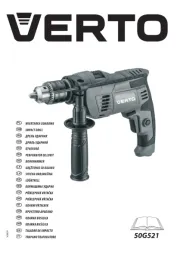
30 Juli 2025
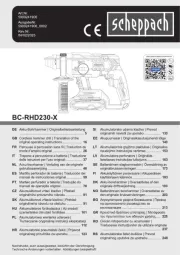
29 Juli 2025
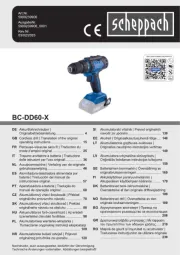
29 Juli 2025
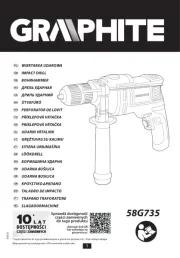
29 Juli 2025
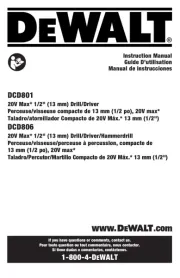
29 Juli 2025
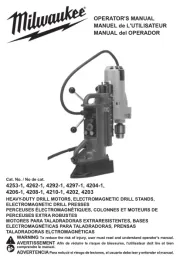
22 Juli 2025
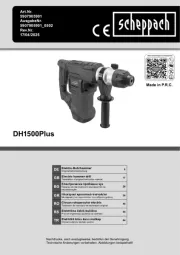
21 Juli 2025
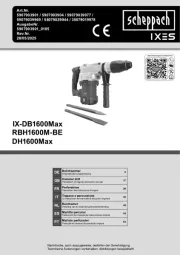
21 Juli 2025
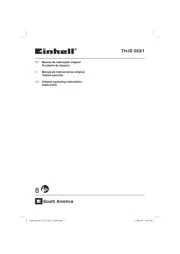
21 Juli 2025
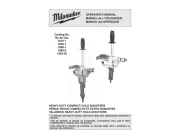
16 Juli 2025